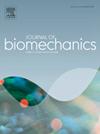Immediate Weight-Bearing after tibial plateau fractures Enhances spatiotemporal gait parameters and minimize fall Risk: A randomized clinical trial
IF 2.4
3区 医学
Q3 BIOPHYSICS
引用次数: 0
Abstract
This randomized clinical trial evaluated the impact of immediate weight-bearing as tolerated on spatiotemporal gait parameters and fall risk in patients undergoing postoperative rehabilitation for tibial plateau fractures. A total of 106 patients who had undergone open reduction and internal fixation (ORIF) for Schatzker I-IV tibial plateau fractures were recruited, with 39 meeting the inclusion criteria and 10 lost to follow-up. Patients were randomly assigned to a non-weight-bearing group (NWB), following a 6-week non-weight-bearing rehabilitation protocol, or a weight-bearing group (WB), allowed immediate weight-bearing. Both groups received the same therapeutic exercise program. Gait parameters were assessed three months post-surgery, including step length, stride length, single stance time, double stance time, step time, stride time, velocity, cadence, stride width, and gait and balance scores from Tinetti Performance Oriented Mobility Assessment (POMA). Of the 29 patients who completed the study, significant differences in favor of the WB group were observed for affected limb step length (p = 0.010), sound limb step length (p = 0.013), stride length (p = 0.010), affected single limb stance time (p = 0.001), sound single limb stance time (p = 0.007), velocity (p = 0.021), and POMA scores for balance (p = 0.021) and gait (p = 0.002). Immediate weight-bearing as tolerated after ORIF for Schatzker I-IV tibial plateau fractures resulted in improved spatiotemporal gait parameters and reduced fall risk.
胫骨平台骨折后立即负重可提高时空步态参数并降低跌倒风险:随机临床试验
本文章由计算机程序翻译,如有差异,请以英文原文为准。
求助全文
约1分钟内获得全文
求助全文
来源期刊

Journal of biomechanics
生物-工程:生物医学
CiteScore
5.10
自引率
4.20%
发文量
345
审稿时长
1 months
期刊介绍:
The Journal of Biomechanics publishes reports of original and substantial findings using the principles of mechanics to explore biological problems. Analytical, as well as experimental papers may be submitted, and the journal accepts original articles, surveys and perspective articles (usually by Editorial invitation only), book reviews and letters to the Editor. The criteria for acceptance of manuscripts include excellence, novelty, significance, clarity, conciseness and interest to the readership.
Papers published in the journal may cover a wide range of topics in biomechanics, including, but not limited to:
-Fundamental Topics - Biomechanics of the musculoskeletal, cardiovascular, and respiratory systems, mechanics of hard and soft tissues, biofluid mechanics, mechanics of prostheses and implant-tissue interfaces, mechanics of cells.
-Cardiovascular and Respiratory Biomechanics - Mechanics of blood-flow, air-flow, mechanics of the soft tissues, flow-tissue or flow-prosthesis interactions.
-Cell Biomechanics - Biomechanic analyses of cells, membranes and sub-cellular structures; the relationship of the mechanical environment to cell and tissue response.
-Dental Biomechanics - Design and analysis of dental tissues and prostheses, mechanics of chewing.
-Functional Tissue Engineering - The role of biomechanical factors in engineered tissue replacements and regenerative medicine.
-Injury Biomechanics - Mechanics of impact and trauma, dynamics of man-machine interaction.
-Molecular Biomechanics - Mechanical analyses of biomolecules.
-Orthopedic Biomechanics - Mechanics of fracture and fracture fixation, mechanics of implants and implant fixation, mechanics of bones and joints, wear of natural and artificial joints.
-Rehabilitation Biomechanics - Analyses of gait, mechanics of prosthetics and orthotics.
-Sports Biomechanics - Mechanical analyses of sports performance.
 求助内容:
求助内容: 应助结果提醒方式:
应助结果提醒方式:


